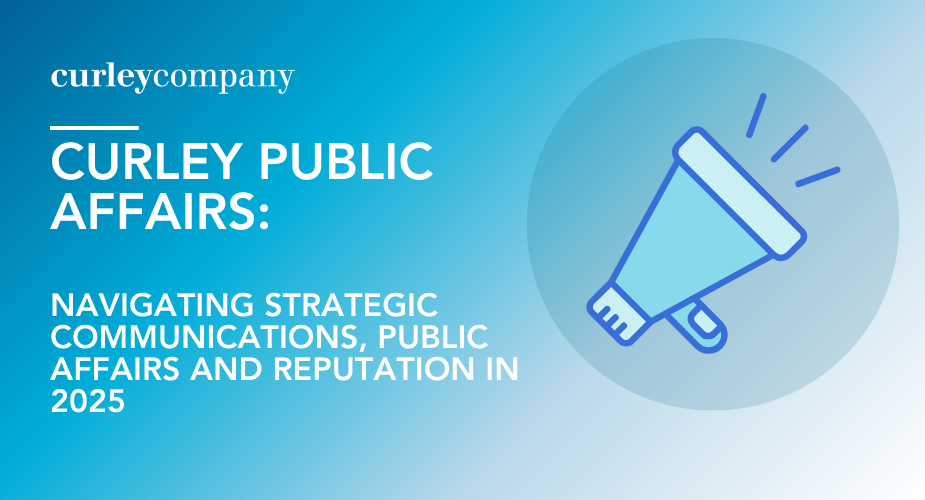Curley Company’s Point of View: Navigating A Rapidly Shifting Public Affairs Environment
A Report from Curley Company Public Affairs by Jeannine Ginivan and Nicole Ryan
News is moving fast and changing by the hour – complicated and monumental policy changes grab attention one minute, with economic news and foreign policy sweeping in the next. To amplify our client’s impact – and remain nimble and relevant – the Curley public affairs team is leveraging robust tactics to ensure our clients continue to hit their reputation and advocacy goals.
Approaching the First 100 Days and Beyond
1. Embrace the “Reputation-First” Era
- Observation: The tech industry’s spotlight at the inauguration demonstrates how sectors with outsized influence must prioritize managing their public perception. This trend is not limited to Silicon Valley but applies across industries, including healthcare, finance and energy.
- Implication: Organizations need to shift from reactive reputation management to proactive reputation building. This requires clear messaging deployed to meet audiences where they are, robust stakeholder engagement and transparency.
- Action: Proactively assess vulnerabilities and develop strategies to protect against reputational risks, especially in areas where your organization is likely to face scrutiny. Highlight policies where you align with policymakers and regulators to create opportunities that build trust and neutralize potential vulnerabilities.
2. Advocacy in an Age of Accountability
- Observation: As public trust in institutions continues to erode, industries face increasing pressure to demonstrate accountability. From tech leaders to sectors like healthcare, trade and insurance, every decision, whether financial or policy-related, is under scrutiny. Whether your organization is a startup or a global institution, organizations can expect intense examination from diverse stakeholders for how they align their actions with their stated values.
- Implication: Effective advocacy requires organizations to articulate not only their business interests but also their impact on society and the communities in which they operate. Thus, integrating advocacy with communications and marketing functions is critical. Stakeholders, from regulators to consumers, expect advocacy to align with values, and pressure to hold organizations accountable will increase from all sides.
- Action: Craft strategic communications and public affairs campaigns that emphasize shared value and impact. Clearly define what you are championing and defending and articulate the broader impact on constituents. Costco’s recent statements to shareholders about their approach to inclusion in the wake of rollbacks from other organizations is a great example of this in action. Engage in coalitions that amplify collective impact while showcasing leadership on specific issues, such as access to healthcare, equitable trade policies or immigration reform.
3. Adapt to Shifting Policy and Regulatory Landscapes
- Observation: New administrations often bring shifts in priorities. In 2025, expect a focus on technology regulation, climate initiatives, public health, immigration and tax policy reform.
- Implication: Organizations must prepare for potential policy changes while staying agile enough to adapt strategies as new regulations emerge.
- Action: Proactively communicate your organization’s values and operational principles to mitigate litigation risks and reduce potential conflicts with federal regulators. Develop strategic communication plans in preparation for various regulatory outcomes, especially as changes to the Chevron Doctrine now distribute the burden of proof more evenly between the government and the private sector. Regularly map stakeholders to identify supporters, opponents and emerging key players.
4. Harness the Power of Strategic Partnerships
- Observation: In his inaugural address, President Trump highlighted numerous areas where he believes the government has fallen short in serving its constituents, from natural disasters in North Carolina to wildfires in Southern California, and from struggling healthcare systems to educational challenges to immigration and beyond. The scale of these issues underscores the need for public-private partnerships to collaborate on effective solutions. Sectors like healthcare, public health and housing will increasingly rely on these alliances to tackle complex challenges.
- Implication: Strategic partnerships can strengthen advocacy efforts and elevate an organization’s reputation and effectively communicate its impact.
- Action: Identify potential partners whose goals align with yours. Use joint initiatives to amplify your message and demonstrate a commitment to the greater societal good, such as pandemic preparedness, equitable economic growth and climate resilience.
5. Leverage a “Legacy Plus” Channel Strategy for Authentic Engagement
- Observation: The tech sector’s visibility at the inauguration underscores the growing importance of digital platforms as key channels for communication, reputation management and advocacy.
- Implication: Organizations must adopt a “legacy plus” channel strategy, ensuring their messaging resonates across both traditional media (broadcast, print) and emerging platforms (podcasts, newsletters, etc.), as well as on their owned channels (websites, social media, etc.)
- Action: Invest in data-driven communications to personalize outreach. Expand beyond legacy media by incorporating emerging platforms like podcasts, Substacks and influencer partnerships, while also leveraging owned content on websites, targeted newsletters and social channels. Use technology to enhance transparency and build trust with stakeholders by meeting them where they receive news and information.
Protecting Interests While Advocating for Issues
To balance reputation management with advocacy, organizations must:
- Prioritize stakeholder alignment: Ensure messaging reflects the values of employees, consumers and investors.
- Leverage insights through data-driven trendspotting: Stay ahead of trends and potential crises with robust issues management protocols.
- Communicate consistently: Build trust by maintaining consistency across all communications channels.
- Anticipate reputational risks: Regularly assess vulnerabilities and prepare crisis plans to mitigate potential fallout.
- Stay nimble: Reassess when to be vocal and when to remain silent, adapting strategy to the evolving political and media landscape. Leverage insights into how influencers and decision-makers consume information, from Substacks to podcasts.
The Takeaway
Organizations that prioritize reputation, embrace advocacy with integrity and leverage strategic partnerships will be well-positioned to thrive. By aligning your strategic communications and public affairs programming with your values and staying agile in the ever-changing geopolitical landscape, you can protect your interests while advancing the issues that matter most.









